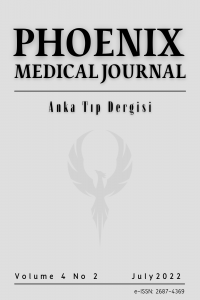Öz
Kırk dört yaşında erkek hasta, düşme sonucu her iki el bileğinde ağrı şikayetiyle acil servise başvurdu. Hastanın düşerken her iki el bileğinin dorsifleksiyonda olduğu, ayrıca ek bir yaralanması olmadığı öğrenildi. Glaskow koma skalası skoru 15, vital değerleri normal olan hastanın her iki el bileği ulnar yüzeyin palpasyonu ve ulnar deviasyonu ile ağrısı olduğu, sol el bileği dorsal yüzeyinin ödemli olduğu görüldü. Ayrıca sol el enfiye çukurunun palpasyonu ile ağrısı olduğu görüldü. Hastanın bilateral ulnar sinir, ulnar ve radial arter muayeneleri normal olarak değerlendirildi. Çekilen radyografilerde, sağ el grafisinde triquetrum kırığı, sol el grafisinde ise triquetrum kırığı ve skafoid kırığı olduğu görüldü. Triquetrum kırıkları ön arka grafilerde belirgin görünmemekte iken, her iki lateral grafide belirgin biçimde görüldü (Şekil 1). Sağ el için kısa kol atel, sol el için skafoid alçısı yapılan hasta 6 haftalık el bileği immobilizasyonu sonrası sekelsiz olarak iyileşti.
Triquetrum kırıkları genellikle dorsal kortex kırıkları ve cisim kırıkları olarak ikiye ayrılır. Dorsal kortex kırıkları daha sık olup, genellikle avülsiyon fraktürü şeklinde görülmektedir. Özellikle dorsifleksiyondaki el üzerine düşme şeklindeki travmalarla oluşurlar. Bizim hastamızda da benzer mekanizma ile düşme hikayesi mevcuttu.
Triquetrum kırıklarının tanınabilmesi için ön-arka grafiye ek olarak, lateral ve oblik grafiler çekilmelidir. Özellikle dorsal kortex kırıkları ön-arka grafide görünmeyebilirken, avülse olan parça lateral grafide daha iyi görünür. Triquetrum kırıklarının lateral grafideki görünümü, skafoid ve lunat kemikle beraber oluşturduğu tipik şekil nedeniyle literatürde “pooping duck sign” olarak adlandırılmıştır (Şekil 2). Bizim olgumuzda da ön arka grafide her iki triquetrum kırığı açıkça seçilememesine rağmen, lateral grafide tipik bulgusu ile daha açık izlenmiştir. Triquetrum kırıkları lateral radyografide daha belirgin şekilde görülebilen karpal kemik kırıklarına iyi bir örnek olup, lateral grafideki spesifik bulgusunun bilinmesi tanıya yardımcı olabilir.
Anahtar Kelimeler
Proje Numarası
-
Kaynakça
- Papp S. Carpal bone fractures. Orthop Clin North Am. 2007;38(2):251-260.
- Christie BM, Michelotti BF. Fractures of the carpal bones. Clin Plast Surg. 2019;46(3):469-477.
- Tyson S, Hatem SF. Easily missed fractures of the upper extremity. Radiol Clin North Am. 2015;53(4):717-736.
- Catalano LW 3rd, Minhas SV, Kirby DJ. Evaluation and management of carpal fractures other than the scaphoid. J Am Acad Orthop Surg. 2020;28(15):e651-e661.
Öz
A 44-year-old male patient presented to the emergency department with pain in both wrists because of falling. It was learned that both wrists of the patient were in dorsiflexion while falling, and there was no additional injury. The Glasgow coma scale score was 15; vital values were within normal limits. The patient had bilateral wrist tenderness, pain with ulnar deviation, and edema on the dorsal side. In addition, he had pain with palpation of the left snuff box. Examinations of the ulnar and radial nerves and arteries were normal. X-rays showed a triquetrum fracture in the right hand, and a triquetrum and scaphoid fracture in the left hand. While triquetrum fractures were not apparent on anterior-posterior radiographs, they were clearly visible on both lateral radiographs (Figure 1). With a short-arm splint for the right hand and a scaphoid cast for the left hand, the patient recovered without sequelae after 6 weeks of wrist immobilization.
Triquetrum fractures are generally classified as dorsal cortex fractures and body fractures. Dorsal cortex fractures are more common and are usually seen as avulsion fractures. They occur with trauma, especially in the form of falling with wrist dorsiflexion. Our patient also fell with the same mechanism. To diagnose triquetrum fractures, lateral and oblique radiographs should be performed in addition to anterior-posterior radiographs. In particular, dorsal cortex fractures may not be visible on the anteroposterior radiograph, while the avulsion fragment is better seen on the lateral radiograph. The appearance of triquetral fractures on the lateral radiograph is called the "pooping duck sign" because of the typical shape it forms with the scaphoid and lunate bone (Figure 2). In our case, although both triquetrum fractures could not be clearly seen on the anterior-posterior radiograph, they were seen more clearly with typical findings on the lateral radiograph. Triquetrum fractures are typical of carpal bone fractures, which can be seen more prominently on lateral radiographs, and knowing the specific finding on the lateral radiograph may help with the diagnosis.
Anahtar Kelimeler
Destekleyen Kurum
-
Proje Numarası
-
Teşekkür
-
Kaynakça
- Papp S. Carpal bone fractures. Orthop Clin North Am. 2007;38(2):251-260.
- Christie BM, Michelotti BF. Fractures of the carpal bones. Clin Plast Surg. 2019;46(3):469-477.
- Tyson S, Hatem SF. Easily missed fractures of the upper extremity. Radiol Clin North Am. 2015;53(4):717-736.
- Catalano LW 3rd, Minhas SV, Kirby DJ. Evaluation and management of carpal fractures other than the scaphoid. J Am Acad Orthop Surg. 2020;28(15):e651-e661.
Ayrıntılar
| Birincil Dil | İngilizce |
|---|---|
| Konular | Acil Tıp |
| Bölüm | Görüntü Sunumu |
| Yazarlar | |
| Proje Numarası | - |
| Yayımlanma Tarihi | 1 Temmuz 2022 |
| Gönderilme Tarihi | 31 Ocak 2022 |
| Kabul Tarihi | 16 Şubat 2022 |
| Yayımlandığı Sayı | Yıl 2022 Cilt: 4 Sayı: 2 |

Anka Tıp Dergisi Creative Commons Atıf 4.0 Uluslararası Lisansı ile lisanslanmıştır.

Anka Tıp Dergisi Budapeşte Açık Erişim Deklarasyonu’nu imzalamıştır.

